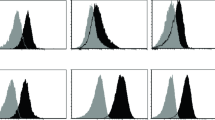Abstract
IL-2 is a major growth factor for all T-cell subsets acting via a specific membrane receptor. To investigate its role in the pathogenesis of cutaneous T-cell lymphomas (CTCLs), we analysed the expression of high-affinity IL-2 receptors (IL-2Rs) on proliferating cells in these disorders. We showed by immunohistochemical double staining that most cycling cells do not express high-affinity IL-2Rs. Four T-cell lines were established from patients with CTCLs. Two lines required both IL-2 and IL-4 for growth, one line required IL-2 and one line IL-4 alone. The last of these lacked expression of the IL-2R α-chain. Thus, IL-2 may not be the only, or the most important, growth stimulus in CTCLs and reactive skin infiltrates. T helper cells, which dominated the infiltrate, might represent TH2 cells.
Similar content being viewed by others
References
Boehncke W-H, Schulte-Rebbelmund H, Sterry W (1989) Plasma cells in the dermal infiltrate of mycosis fungoides are of polyclonal origin. Acta Derm Venereol (Stockh) 69: 166–169
Bottomly K (1988) A functional dichotomy in CD4+ T lymphocytes. Immunol Today 9: 268–274
Crabtree GR (1989) Contingent genetic regulatory events in T lymphocyte activation. Science 243: 355–361
Depper JM, Leonard WJ, Krönke M, Waldmann TA, Greene WC (1984) Augmented T cell growth factor receptor expression in HTLV-1-infected human leukemic T cells. J Immunol 133: 1691–1695
Feller AC, Parwaresch MR, Wacker HH, Radzun HJ, Lennert K (1983) Combined immunochemical staining for surface IgG and lymphocyte subsets with monoclonal antibodies in human tonsils. Histochem J 15: 557–562
Gerdes J, Lemke H, Baisch H, Wacker HH, Schwab U, Stein H (1984) Cell cycle analysis of a cell proliferation associated human nuclear antigen defined by the monoclonal antibody Ki-67. J Immunol 133: 1710–1715
Hatakeyama M, Tsudo M, Minamoto S, Kono T, Doi T, Miyata T, Miyasaka M, Tanigushi T (1989) Interleukin-2 receptorβ chain gene: generation of three receptor forms by cloned human alpha and beta chain cDNAs. Science 244: 551–556
Howard M, Matis L, Malek TR, Shevach E, Kell W, Cohen D, Nakanishi K, Paul WE (1983) Interleukin 2 induces antigen reactive T cell lines to secrete BCGF-1. J Exp Med 158: 2024–2039
Kaltoft K, Bisballe S, Rasmussen HF, Thestrup-Pedersen K, Thomsen K, Sterry W (1987) A continuous T-cell line from a patient with Sezary's syndrome. Arch Dermatol Res 279: 293–298
Leonard WJ, Depper JM, Uchiyama T, Smith KA, Waldman TA, Greene WC (1982) A monoclonal antibody that appears to recognize the receptor for human T cell growth factor: partial characterization of the receptor. Nature 300: 267–269
Neish C, Charley M, Tharp M, Jegasothy BV, Deng JS (1989) Expression of class II antigens and IL-2 receptor on cells from skin infiltrates and peripheral blood mononuclear cells of CTCL patients. J Invest Dermatol 92: 490
Nickoloff BJ, Griffith CEM (1990) Intraepidermal but not dermal T lymphocytes are positive for a cell-cycle associated antigen (Ki-67) in mycosis fungoides. Am J Pathol 136: 261–266
Siebel A, Mielke V, Sterry W (1991) Prognostic criteria in cutaneous pleomorphic T cell lymphoma. Arch Dermatol Res 283: 53
Smith KA (1989) The interleukin 2 receptor. Annu Rev Cell Biol 5: 397–425
Sterry W (1985) Mycosis fungoides. In: Berry CL (ed) Dermatopathology. Springer, Berlin Heidelberg New York, pp 167–223
Tsudo M, Kozak RW, Goldman CK, Waldmann TA (1986) Demonstration of a non-Tac peptide that binds interleukin-2: a potential participant in a multichain interleukin-2 receptor complex. Proc Natl Acad Sci USA 83: 9694–9698
Vowels BR, Cassin M, Boufal M, Vonderheid E, Rook AH (1991) Cutaneous T cell lymphoma may represent a Th2 helper cell proliferative disease. J Invest Dermatol 96: 609
Yagita H, Nakata M, Azuma A, Nitta T, Takeshita T, Sugamura K, Okumura K (1989) Activation of peripheral blood T cells via the p75 interleukin 2 receptor. J Exp Med 170: 1445–1450
Author information
Authors and Affiliations
Rights and permissions
About this article
Cite this article
Boehncke, W.H., Gerdes, J., Wiese, M. et al. A majority of proliferating T cells in cutaneous malignant T cell lymphomas may lack the high affinity IL-2 receptor (CD25). Arch Dermatol Res 285, 127–130 (1993). https://doi.org/10.1007/BF01112913
Received:
Issue Date:
DOI: https://doi.org/10.1007/BF01112913




